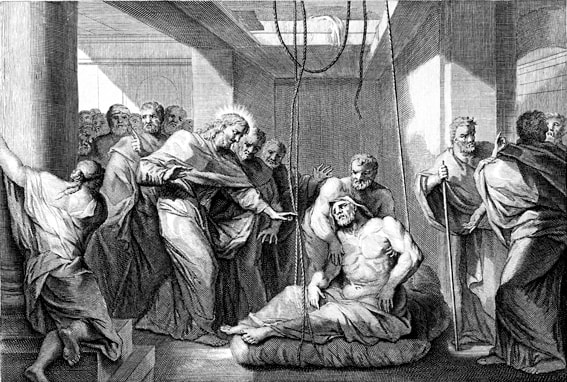|
Progressing through Part 2 of The Lord, Guardini moved into meditations on sin and death. More specifically, he focuses on Christ’s mission to forgive sins and to conquer death. We see Jesus several times throughout the Gospels telling people their sins are forgiven. Often it will occur right before a healing. When the paralytic is lowered through the roof to Jesus so that he might be healed, Jesus doesn’t start with the physical healing. He starts with “Son, your sins are forgiven” (Mark 2:5). It’s only after Jesus senses the skepticism of the scribes that he tells the man to take up his mat and walk.
This story is interesting most, perhaps, because of the scribes. A miracle healer is easy to believe in. You can see the effects of a healer quite easily and clearly. But one who forgives sin? Not only does it seem absurd and even blasphemous, for only God can forgive sins, but also it is not observable. How can anyone know whether their own sins are forgiven, let alone the sins of someone else, except by faith? I wager any one of us in the room that day would have been just as skeptical as the scribes. Here is a man saying “your sins are forgiven” in a way that makes it seem like that’s supposed to be significant and efficacious in some way. But it doesn’t appear significant at all to them. They just see a man saying words, blasphemous words, even, seeing as they do not believe. Either he is a blasphemer, or perhaps he is mad. It’s only after they see Jesus heal the paralytic man with a single command, “I say to you, stand up, take your mat and go to your home” that they begin to believe (though in Matthew’s account of this miracle, the evangelist points out that they did not believe, but rather thought Jesus was a mere man to whom God had gifted this power). It’s also interesting that Jesus appears to heal the man of his physical malady primarily as a sign for others. Indeed, he also says that it is good he was not present when Lazarus died, as now Lazarus will be a sign for people to believe when Jesus raises him from the dead. Jesus seems only secondarily focused on physical healing here. He is primarily focused on forgiving sins. This seems fitting, as Christ knows that the true source of all the problems in the world, the true ultimate disease of man, is not some physical affliction, but sin itself. We saw a couple days ago how we are called in the Sermon on the Mount to attack the root of our sinful behavior, our disposition toward it, rather than the behavior itself. Here we see Jesus not focused on the symptoms of a world full of sin, but on the root of it all—on the sin that flung the world into such disarray. And why is this? Because the one thing Jesus came to do, above all, was to conquer death—to offer eternal life to all who believe. Adam brought death into the world, by his sin, and now Jesus, the Second Adam, comes to defeat it. Jesus attacks the very source of death by forgiving our sins. This doesn’t mean our sins no longer exist, as if they never occurred. They did, and we did them. It also doesn’t mean that we will never sin again, nor that God merely looks away from our sin and ignores it. “Through God’s forgiveness, in the eyes of his sacred truth I am no longer a sinner; in the profoundest depths of my conscience I am no longer guilty.” We still must contend with the consequences of the sins for which we have been forgiven, by reconciling ourselves with those we have wronged, but our guilt is truly removed through forgiveness. And in that forgiveness, so too opens for us the narrow gate that leads to eternal life.
0 Comments
|
Series Info
Every day of Lent, I am writing a reflection piece on two chapters of "The Lord" by Romano Guardini. If you'd like to read or follow along, you can find the full calendar of where we're at below, or Click Here for the main landing page. Archives
April 2020
Categories
All
|

 RSS Feed
RSS Feed